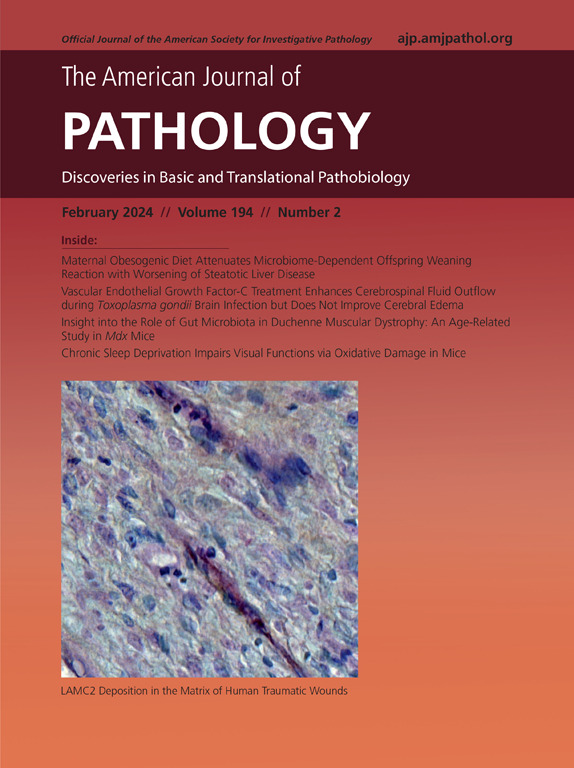Cross-Species Functional Genomic Screens Identify Novel Therapeutic Targets in Malignant Peripheral Nerve Sheath Tumors
IF 3.6
2区 医学
Q1 PATHOLOGY
引用次数: 0
Abstract
As oncogenic pathways are highly conserved in vertebrates, genetically engineered mouse models can potentially be used to identify therapeutic targets relevant to rare human cancers such as malignant peripheral nerve sheath tumors (MPNSTs). To test this, genome-scale shRNA screens designed to identify genes driving proliferation and survival were performed in five MPNST cultures derived from myelin protein zero-glial growth factor beta 3 (P0-GGFβ3) mice and three human MPNST cell lines. Several hundred gene hits mediating proliferation and survival were identified in human and mouse MPNST cells, many of which have been implicated in proliferation and survival in other cancers and/or mediate the pathogenesis of other cancer types. These hits and their associated signaling pathways extensively overlapped in human and mouse MPNST cells. A drug discovery pathway based on the Drug-Gene Interaction Database was developed to identify hits encoding druggable targets. Five druggable targets were selected for validation, with four of the five agents tested (the DNA polymerase α1 inhibitor clofarabine, the DNA nucleotidylexotransferase inhibitor cordycepin, the BCL6 inhibitor 79-6, and the lysophosphatidic acid receptor 1/3 inhibitor Ki16425) proving effective against human MPNST cells. Clofarabine was especially effective, potently reducing cell numbers at low nanomolar concentrations and inducing a senescent phenotype, possibly via the p53/p21 pathway. These results demonstrate the utility of cross-species functional oncogenomics for the discovery of novel therapeutic targets relevant to human MPNSTs and suggest that clofarabine warrants further evaluation for its therapeutic potential.

跨物种功能基因组筛选确定恶性周围神经鞘肿瘤的新治疗靶点。
由于致癌途径在脊椎动物中高度保守,基因工程小鼠模型可以潜在地用于识别与罕见的人类癌症(如恶性周围神经鞘肿瘤(MPNSTs))相关的治疗靶点。为了验证这一点,研究人员在5个来自P0-GGFβ3小鼠和3个人类MPNST细胞系的MPNST培养物中进行了基因组规模的shRNA筛选,旨在鉴定驱动增殖和存活的基因。在人类和小鼠MPNST细胞中发现了数百个介导增殖和存活的基因,其中许多基因与其他癌症的增殖和存活有关和/或介导其他癌症类型的发病机制。这些撞击及其相关的信号通路在人和小鼠MPNST细胞中广泛重叠。建立了一种基于药物-基因相互作用数据库的药物发现途径,以识别编码可药物靶点的命中点。选择5个可药物靶点进行验证,5种药物中有4种被证明对人MPNST细胞有效(POLA1抑制剂氯法拉宾、DNTT抑制剂虫草素、BCL6抑制剂79-6和LPAR1/3抑制剂Ki16425)。氯法拉滨特别有效,在低纳摩尔浓度下能有效减少细胞数量,并诱导衰老表型,可能是通过p53/p21途径。这些结果证明了跨物种功能肿瘤基因组学在发现与人类MPNSTs相关的新治疗靶点方面的效用,并表明氯法拉滨的治疗潜力值得进一步评估。
本文章由计算机程序翻译,如有差异,请以英文原文为准。
求助全文
约1分钟内获得全文
求助全文
来源期刊
CiteScore
11.40
自引率
0.00%
发文量
178
审稿时长
30 days
期刊介绍:
The American Journal of Pathology, official journal of the American Society for Investigative Pathology, published by Elsevier, Inc., seeks high-quality original research reports, reviews, and commentaries related to the molecular and cellular basis of disease. The editors will consider basic, translational, and clinical investigations that directly address mechanisms of pathogenesis or provide a foundation for future mechanistic inquiries. Examples of such foundational investigations include data mining, identification of biomarkers, molecular pathology, and discovery research. Foundational studies that incorporate deep learning and artificial intelligence are also welcome. High priority is given to studies of human disease and relevant experimental models using molecular, cellular, and organismal approaches.

 求助内容:
求助内容: 应助结果提醒方式:
应助结果提醒方式:


